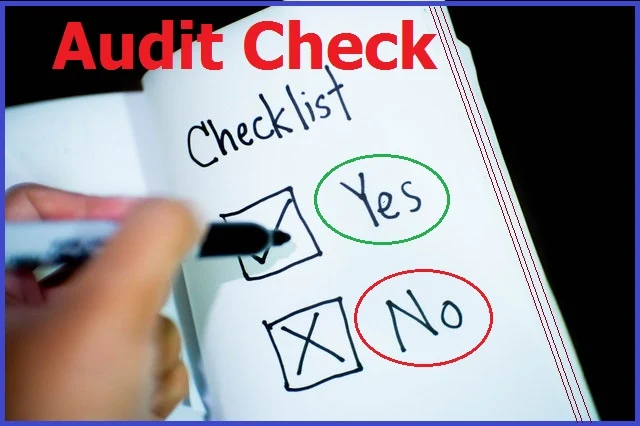Professional auditors should preferably be knowledgeable in the following fields through one-on-one training, classroom training, videotapes, and reading.
{tocify} $title={Table of Contents}
- Product itself
- Product characteristics
- Product/process flow
- Process documents and records
- Identification and control of material, parts components.
- Products handling procedure and limitations
- Test Control.
- Operating environment
- Feedback system
- Record-keeping requirements.
- Corrective action.
- Personnel interface.
Checklist For Audits
Audit Type .......
1. Equipment/tester/tools control
- Calibration control/schedule.
- Monitoring activity.
- Certification status.
- Maintenance status.
- Data integrity/verification.
- Standards check.
- Availability of tools.
- Startup/shutdown.
- Correlation verification.
2. Operator
- Qualification status.
- Compliance with the procedure.
- Output (quality) verification/operator capability.
- Data recording verification.
- Rework verification.
- Observation for conformance to procedures.
- Product handling.
- Workmanship.
3. Documentation
- Line documents ( availability, readability, accessibility, document content, level).
- Document adherence.
- Quality documents like inspection instructions, inspection tools, and applicable test procedures.
- Routing/flow chart/traveler.
- Maintenance documents.
- Training documents.
- Experimental procedure.
- Records/log books.
- Off-specs.
4. Parts / Assembly
- Conformance to spec.
- EC level.
- Handling/packaging/storage/shipping.
- Data availability.
- Scrap/manufacturing engineering hold / material review board parts (non-conforming part).
- Traceability.
- In-process product.
- Finished product.
- Non-conforming product control and disposition.
5. Process control status
- Process control instructions/actions.
- Control Chart status.
- Check corrective actions.
- Verify manufacturing data.
6. Environment
- Cleanliness of the work area.
- Particle count verification.
- Humidity recording.
- Temperature recording.
- General housekeeping.
7. Calibration/standards audits
- Calibration evidence.
- Overdue for calibration.
- Monitor standards.
8. Chemicals/materials control
- Shelf life labeling.
- Receiving inspection status.
- Handling/storage.
- Shelf life.
- Non-conforming chemicals/materials control and disposition.
- Relationship to work instructions, Manufacturing Engineering, and Material review board.
9. Software system
- Software control.
- Data integrity/verification.
10. Quality assurance self-audits
- Inspection data verification.
- Housekeeping.
- Inspector training/qualification.
11. Production control crib
- Finished product control.
- Storage/handling.
- Receiving inspection status.
- EC level.
12. Rework
- Procedures.
- Product Quality.
- Product disposition.
13. System audit
- General Administration.
- Product development.
- Product Qualification.
- Functional testing.
- Field Performance.
- Personnel training.
14. Audit
- Material review board.
Audit Rating System
The audit rating system is designed to bring consistency to the evaluation of audit results across the business units. The operation of a rating system is as follows:
1. Each discrepancy will be classified as either major or minor.
Major:- A deviation from a specification or from procedural requirements, which may cause major product malfunction or yield loss at higher level assembly, for example, components not meeting test criteria.
Minor:- A deviation that could create some unwanted variability in the product or process or which presents a slight risk, for example, an unqualified operator working on a product or documents that have not been updated
2. All audit discrepancies will be scored in the following manner:
Major: 04 Point
Minor: 01 Point
Recurrence of major deviation: 8 Point
Recurrence of minor deviation (from last audit): 2 Points. Consecutive 3 items recurrence of minor deviation becomes major: 4 Point.
3. The overall audit rating is obtained by adding the points for observed discrepancies, dividing by the total number of audits, and subtracting from 100.
Rating = 100 - Total point ∕ Total number of audits
4. All major discrepancies require immediate corrective action with a written response.
5. Overall audit ratings are established for percentage(%) Range: 95 to 100% Excellent. 90 to 95% Satisfactory. Below 90% unsatisfactory, requiring immediate attention and corrective action response.



